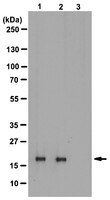05-746R-25UL Sigma-AldrichAnti-phospho-Histone H3 (Thr3) Antibody, clone JY325 (rabbit monoclonal)
Anti-phospho-Histone H3 (Thr3) Antibody, clone JY325 is a Rabbit Monoclonal Antibody for detection of phospho-Histone H3 (Thr3) also known as Histone H3.1 & has been validated in WB, PIA.
More>> Anti-phospho-Histone H3 (Thr3) Antibody, clone JY325 is a Rabbit Monoclonal Antibody for detection of phospho-Histone H3 (Thr3) also known as Histone H3.1 & has been validated in WB, PIA. Less<<Recommended Products
Overview
| Replacement Information |
|---|
| References |
|---|
| Product Information | |
|---|---|
| Format | Purified |
| Control |
|
| Presentation | Purified rabbit monoclonal IgG in buffer containing 0.1 M Tris-Glycine (pH 7.4), 150 mM NaCl with 0.05% sodium azide and 40% glycerol. |
| Quality Level | MQ100 |
| Physicochemical Information |
|---|
| Dimensions |
|---|
| Materials Information |
|---|
| Toxicological Information |
|---|
| Safety Information according to GHS |
|---|
| Safety Information |
|---|
| Packaging Information | |
|---|---|
| Material Size | 25 µL |
| Transport Information |
|---|
| Supplemental Information |
|---|
| Specifications |
|---|
| Global Trade Item Number | |
|---|---|
| Catalog Number | GTIN |
| 05-746R-25UL | 04054839342417 |
Documentation
Anti-phospho-Histone H3 (Thr3) Antibody, clone JY325 (rabbit monoclonal) Certificates of Analysis
| Title | Lot Number |
|---|---|
| Anti-phospho-Histone H3 (Thr3), clone JY325 (rabbit monoclonal) - 3397923 | 3397923 |








